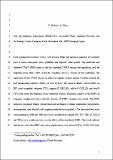Por favor, use este identificador para citar o enlazar a este item:
http://hdl.handle.net/10261/75479COMPARTIR / EXPORTAR:
 SHARE SHARE
 CORE
BASE CORE
BASE
|
|
| Visualizar otros formatos: MARC | Dublin Core | RDF | ORE | MODS | METS | DIDL | DATACITE | |

| Título: | Evaluation of best management practices under intensive irrigation using SWAT model |
Autor: | Dechmi, Farida CSIC ORCID; Skhiri, Ahmed CSIC | Palabras clave: | Nutrients management practices Nutrients losses Phosphorus Sediment yield Tillage |
Fecha de publicación: | may-2013 | Editor: | Elsevier | Citación: | Dechmi F, Skhiri A. Evaluation of best management practices under intensive irrigation using SWAT model. Agricultural Water Management 123: 55–64 (2013) | Resumen: | Land management practices such as conservation tillage and optimum irrigation are routinely used to reduce non-point source pollution and improve water quality. The calibrated and validated SWAT-IRRIG model is the first modified SWAT version that reproduces well the irrigation return flows (IRF) when the irrigation source is outside of the watershed. The application of this SWAT version in intensive irrigated systems permits to better evaluate the best management practices (BMPs) in such systems. This paper evaluates several BMPs on IRF, total suspended sediment (TSS), organic P (ORG_P), soluble P (SOL_P), and total P (TP) at the outlet Del Reguero stream watershed (Spain). Economic impacts of the BMPs on crop gross margin were also evaluated. In total, 20 BMPs scenarios were tested. The BMPs proposed considered tillage (conservation and no-tillage), fertilizer application (incorporated, recommended, and reduced), and irrigation (adjusted to crop needs). The measured data series corresponding to 2008 and 2009 years were considered to estimate IRF, TSS, ORG_P, SOL_P and TP losses as a reference to assess the effects of the considered BMPs. The results indicate that the best individual BMP (adjusted irrigation water use) reduced IRF by 31.4%, TSS loads by 33.5% and TP loads by 12.8%. When individual BMPs were combined, the load reductions were even increased. The BMP scenario combining optimum irrigation application, conservation tillage and reduced P fertilizer dose was the best, leading to a TP load reduction of about 22.6%. For corn and alfalfa, the best BMP scenario was the combination between conservation tillage and reduced P fertilizer dose, increasing the crop gross margin by 309 € ha−1 and 188 € ha−1, respectively. For sunflower and barley, the best scenario combined the adjusted irrigation water use, conservation tillage and reduced P fertilizer dose (gross margin increase of 171 € ha−1 and 307 € ha−1, respectively). | Descripción: | 39 Pags., 8 Tabls., 3 Figs. The definitive version is available at: http://www.sciencedirect.com/science/journal/03783774 | Versión del editor: | http://dx.doi.org/10.1016/j.agwat.2013.03.016 | URI: | http://hdl.handle.net/10261/75479 | DOI: | 10.1016/j.agwat.2013.03.016 | ISSN: | 0378-3774 |
| Aparece en las colecciones: | (EEAD) Artículos |
Ficheros en este ítem:
| Fichero | Descripción | Tamaño | Formato | |
|---|---|---|---|---|
| DechmiF_AgricWatManag_2013.pdf | 231,95 kB | Adobe PDF |  Visualizar/Abrir |
CORE Recommender
SCOPUSTM
Citations
49
checked on 10-abr-2024
WEB OF SCIENCETM
Citations
46
checked on 22-feb-2024
Page view(s)
309
checked on 19-abr-2024
Download(s)
362
checked on 19-abr-2024
Google ScholarTM
Check
Altmetric
Altmetric
NOTA: Los ítems de Digital.CSIC están protegidos por copyright, con todos los derechos reservados, a menos que se indique lo contrario.
